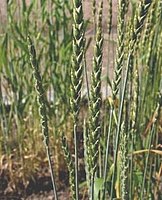
Sensory evaluation of Chinese white salted noodles and steamed bread made with Australian and Chinese wheat flour
Sign Up to like & getrecommendations! Published in 2019 at "Cereal Chemistry"
DOI: 10.1002/cche.10089
Abstract: Background and objectives Chinese white salted noodles (CWSN ) and steamed bread (CSB ) are staple foods and represent approximately 65% of wheat consumption in China. Sensory evaluation was used to measure the quality attributes… read more here.
Keywords: steamed bread; extraction; wheat; chinese wheat ... See more keywords

Fingerprinting of wheat protein profiles for improved distinction between wheat cultivars and species
Sign Up to like & getrecommendations! Published in 2020 at "Cereal Chemistry"
DOI: 10.1002/cche.10323
Abstract: Background and objectives Wheat protein composition is commonly characterized by reversed‐phase (RP)‐HPLC‐UV after extraction of albumins/globulins, gliadins (ω5‐, ω1,2‐, α‐, and γ‐gliadins), and glutenins (high‐ and low‐molecular‐weight glutenin subunits). However, this traditional classification does not… read more here.
Keywords: integration; wheat; wheat protein; wheat cultivars ... See more keywords

Wild emmer chromosome arm substitution lines: Useful resources for wheat genetic study and breeding
Sign Up to like & getrecommendations! Published in 2020 at "Crop Science"
DOI: 10.1002/csc2.20022
Abstract: As the progenitor of durum wheat (Triticum durum Desf.) and common wheat (T. aestivum L.), wild emmer wheat (T. turgidum L. subsp. dicoccoides, TTD) has many valuable alleles for enlarging the genetic pool of common… read more here.
Keywords: arm substitution; common wheat; wheat; wild emmer ... See more keywords

Breeding for resilience to increasing temperatures: A field trial assessing genetic variation in soft red winter wheat
Sign Up to like & getrecommendations! Published in 2018 at "Ecology and Evolution"
DOI: 10.1002/ece3.4668
Abstract: Abstract Breeding for resilience to climate change is a daunting prospect. Crop and climate models tell us that global wheat yields are likely to decline as the climate warms, causing a significant risk to global… read more here.
Keywords: red winter; breeding resilience; wheat; soft red ... See more keywords

Reproductive and genetic roles of the maternal progenitor in the origin of common wheat (Triticum aestivum L.)
Sign Up to like & getrecommendations! Published in 2020 at "Ecology and Evolution"
DOI: 10.1002/ece3.6985
Abstract: Abstract Common wheat (Triticum aestivum L., AABBDD genome) is thought to have emerged through natural hybridization between Triticum turgidum L. (AABB genome) and Aegilops tauschii Coss. (DD genome). Hybridization barriers and doubling of the trihaploid… read more here.
Keywords: maternal progenitor; common wheat; wheat; wheat triticum ... See more keywords

Domestication provides durum wheat with protection from locust herbivory
Sign Up to like & getrecommendations! Published in 2023 at "Ecology and Evolution"
DOI: 10.1002/ece3.9741
Abstract: Abstract Lower plant resistance to herbivores following domestication has been suggested as the main cause for higher feeding damage in crops than in wild progenitors. While herbivore compensatory feeding has also been proposed as a… read more here.
Keywords: domestication; domestication provides; wheat; resistance ... See more keywords

Determination of phenolic compounds in ancient and modern durum wheat genotypes
Sign Up to like & getrecommendations! Published in 2018 at "ELECTROPHORESIS"
DOI: 10.1002/elps.201700439
Abstract: Due to its significant amount of antioxidants, durum wheat (Triticum turgidum ssp. durum) could potentially contribute to the protection against a number of chronic diseases, such as diabetes, cardiovascular disease, and cancer. The increasing interest… read more here.
Keywords: wheat genotypes; modern durum; wheat; durum wheat ... See more keywords

Variation in mycorrhizal growth response among a spring wheat mapping population shows potential to breed for symbiotic benefit
Sign Up to like & getrecommendations! Published in 2022 at "Food and Energy Security"
DOI: 10.1002/fes3.370
Abstract: Abstract All cereal crops engage in arbuscular mycorrhizal symbioses which can have profound, but sometimes deleterious, effects on plant nutrient acquisition and growth. The mechanisms underlying variable mycorrhizal responsiveness in cereals are not well characterised… read more here.
Keywords: growth response; mapping population; potential breed; growth ... See more keywords

CLIMATE CHANGE IMPACTS AND ADAPTATION FOR CROP MANAGEMENT OF WINTER WHEAT AND MAIZE IN THE SEMI‐ARID REGION OF IRAN
Sign Up to like & getrecommendations! Published in 2019 at "Irrigation and Drainage"
DOI: 10.1002/ird.2373
Abstract: Climate change is expected to lead to declining crop yields in semi‐arid regions due to higher temperatures and more severe droughts, which calls for adaptations in crop management. We used the WOFOST and AquaCrop crop… read more here.
Keywords: crop; climate change; wheat; winter wheat ... See more keywords

Effect of wheat (Triticum aestivum L.) resistance, Fusarium graminearum DNA content, strain potential toxin production, and disease severity on deoxynivalenol content
Sign Up to like & getrecommendations! Published in 2019 at "Journal of Basic Microbiology"
DOI: 10.1002/jobm.201900320
Abstract: Six wheat cultivars with varied resistance to Gibberella zeae (Anamorph, Fusarium graminearum Schwabe) were inoculated with six monoconidial strains of G. zeae to investigate the effect of wheat resistance to Fusarium head blight on deoxynivalenol… read more here.
Keywords: fusarium; dna; wheat; graminearum ... See more keywords

Agri-residual waste, wheat bran as a biosorbent for mitigation of dye pollution in industrial wastewaters.
Sign Up to like & getrecommendations! Published in 2021 at "Journal of basic microbiology"
DOI: 10.1002/jobm.202100502
Abstract: In the current investigation, a comparison of mitigation of industrial-grade, Dispersive Dark Red (DDR) (93.55%), Disperse Orange (DO) (93.48%) and lab grade, Malachite Green (MG) (95.25%), and Congo Red (CR) (97.02%) dyes using biosorptive ability… read more here.
Keywords: wheat; wheat bran; dye pollution; dye ... See more keywords